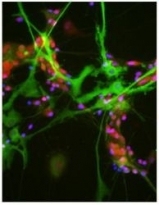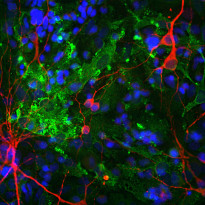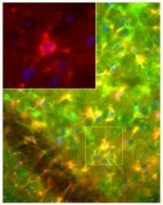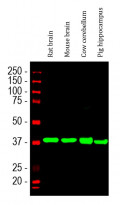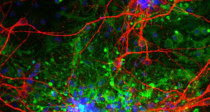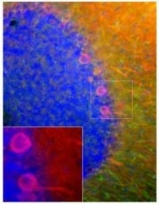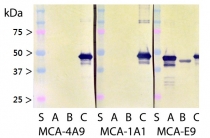ARG10695
anti-Aldolase C antibody [4A9]
anti-Aldolase C antibody [4A9] for ICC/IF,IHC-Frozen sections,Western blot and Human,Mouse,Rat,Cow,Horse,Pig
Overview
| Product Description | Mouse Monoclonal antibody [4A9] recognizes Aldolase C |
|---|---|
| Tested Reactivity | Hu, Ms, Rat, Cow, Hrs, Pig |
| Predict Reactivity | Chk |
| Tested Application | ICC/IF, IHC-Fr, WB |
| Host | Mouse |
| Clonality | Monoclonal |
| Clone | 4A9 |
| Isotype | IgG1 |
| Target Name | Aldolase C |
| Immunogen | N-terminal sequence MPHSYPALSAEQKKELSDIA |
| Conjugation | Un-conjugated |
| Alternate Names | EC 4.1.2.13; Brain-type aldolase; Fructose-bisphosphate aldolase C; ALDC |
Application Instructions
| Application Suggestion |
|
||||||||
|---|---|---|---|---|---|---|---|---|---|
| Application Note | * The dilutions indicate recommended starting dilutions and the optimal dilutions or concentrations should be determined by the scientist. |
Properties
| Form | Liquid |
|---|---|
| Purification | Affinity purification. |
| Buffer | PBS and 50% Glycerol. |
| Stabilizer | 50% Glycerol |
| Concentration | 1 mg/ml |
| Storage Instruction | For continuous use, store undiluted antibody at 2-8°C for up to a week. For long-term storage, aliquot and store at -20°C. Storage in frost free freezers is not recommended. Avoid repeated freeze/thaw cycles. Suggest spin the vial prior to opening. The antibody solution should be gently mixed before use. |
| Note | For laboratory research only, not for drug, diagnostic or other use. |
Bioinformation
| Database Links | |
|---|---|
| Gene Symbol | ALDOC |
| Gene Full Name | aldolase C, fructose-bisphosphate |
| Background | This gene encodes a member of the class I fructose-biphosphate aldolase gene family. Expressed specifically in the hippocampus and Purkinje cells of the brain, the encoded protein is a glycolytic enzyme that catalyzes the reversible aldol cleavage of fructose-1,6-biphosphate and fructose 1-phosphate to dihydroxyacetone phosphate and either glyceraldehyde-3-phosphate or glyceraldehyde, respectively. [provided by RefSeq, Jul 2008] |
| Calculated MW | 39 kDa |
Images (9) Click the Picture to Zoom In
-
ARG10695 anti-Aldolase C antibody [4A9] ICC/IF image
Immunocytochemistry: Rat mixed neuron / glial cultures stained with ARG10695 anti-Aldolase C antibody [4A9] (green) and co-stained with our rabbit antibody to FOX3 / NeuN (red). ARG10695 anti-Aldolase C antibody [4A9] antibody reveals strong cytoplasmic staining in astrocytes, while Rabbit FOX3 / NeuN antibody shows nuclear and distal cytoplasmic staining in neuron cells and is complete absence of astrocytes. Blue is a DNA stain.
-
ARG10695 anti-Aldolase C antibody [4A9] ICC/IF image
Immunofluorescence: Cortical neuron-glial cells from E20 Rat stained with ARG10695 anti-Aldolase C antibody [4A9] (green) at 1:1000 dilution and costained with ARG52328 anti-MAP2 antibody (red) at 1:10000 dilution. Hoechst (blue) for nuclear staining.
The Aldolase C antibody labels cytosolic protein expressed in the glial cells, while the MAP2 antibody stains dendrites and perikarya of mature neurons.
-
ARG10695 anti-Aldolase C antibody [4A9] IHC-Fr image
Immunohistochemistry: Frozen section of Rat cerebellum stained with ARG10695 anti-Aldolase C antibody [4A9] (green) at 1:1000 dilution and costained with ARG52312 anti-GFAP antibody (red) at 1:5000 dilution. Hoechst (blue) for nuclear staining.
Aldolase C antibody selectively labels the perikarya and dendrites of Purkinje cells, while GFAP antibody stains processes of Bergman glia and astrocytic cells.
-
ARG10695 anti-Aldolase C antibody [4A9] IHC-Fr image
Immunohistochemistry: Frozen sections of Mouse brain (fixed by transcardial perfusion with 4% paraformaldehyde) stained with ARG10695 anti-Aldolase C antibody [4A9] (red) and co-stained with chicken anti-Vimentin antibody (green). In the striatum, ARG10695 anti-Aldolase C antibody [4A9] positive astrocytes are highly co-stained with Vimentin antibody, which results in yellow to gold colors. Insets show a higher magnification picture. Nuclei are labeled with DAPI (blue).
-
ARG10695 anti-Aldolase C antibody [4A9] WB image
Western blot: Crude cow cerebellum homogenate stained with ARG10695 anti-Aldolase C antibody [4A9]. Other studies show that this antibody does not recognize the very closely related molecules aldolase A or B.
-
ARG10695 anti-Aldolase C antibody [4A9] WB image
Western blot: Rat brain, Mouse brain, Cow cerebellum and Pig hippocampus lysates stained with ARG10695 anti-Aldolase C antibody [4A9] (green) at 1:2000 dilution.
-
ARG10695 anti-Aldolase C antibody [4A9] IHC-Fr image
Immunohistochemistry: Frozen section of E20 Rat cortical tissue stained with ARG10695 anti-Aldolase C antibody [4A9] (green) at 1:1000 dilution and costained with ARG52328 anti-MAP2 antibody (red) at 1:10000 dilution.
The aldolase C antibody labels cytosolic protein expressed in glial cells, while MAP2 antibody stains dendrites and perikarya of mature neurons.
-
ARG10695 anti-Aldolase C antibody [4A9] IHC-Fr image
Immunohistochemistry: Frozen sections of Mouse brain (fixed by transcardial perfusion with 4% paraformaldehyde) stained with ARG10695 anti-Aldolase C antibody [4A9] (red) and co-stained with chicken anti-Vimentin antibody (green). In the cerebellum, ARG10695 anti-Aldolase C antibody [4A9] positive Purkinje cells do not express vimentin, which results in red color. Insets show a higher magnification picture. Nuclei are labeled with DAPI (blue).
-
ARG10695 anti-Aldolase C antibody [4A9] WB image
Western blot: Recombinant Human Aldolase A, B and C with three monoclonal antibodies as indicated showing binding to all three gene products. Lane labelled S show molecular weight standards, while lanes A, B and C contain recombinant full length His-tagged Human Aldolase A, B and C respectively. The epitope for ARG10695 anti-Aldolase C antibody [4A9] is within the N-terminal peptide of the molecule which is less conserved between the three Aldolases. Clone 1A1 binds to the C-terminal peptide and also is specific for Aldolase C, while clone E9 binds to the less conserved core of the molecule and recognizes all three Aldolase C gene products.
